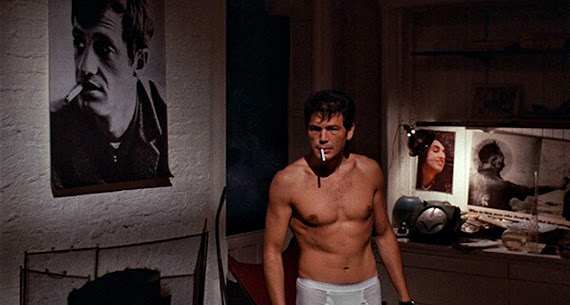 |
| Robert Forster in Medium Cool |
The film centers around a reporter and cameraman for a television station in Chicago played by Robert Forster who was cast at the last minute after John Cassavetes dropped out of the role. We first meet Forster's character, named John Cassellis, filming the results of a fatal automobile accident on a freeway ramp. He is being assisted by a sound man played by Peter Bonerz, most famous for eventually playing a wacky dentist on The Bob Newhart Show. The pair show little empathy for the victim of the crash. To them, the footage they shoot is merely fodder for their station where if it bleeds, it leads. From the start, Wexler is trumpeting his theme that the cool medium of television distances rather than engages the viewer with reality.
John is shown to be a rather unengaged and callow fellow. He is bedding a co-worker, played by Mariana Hill, but the relationship is superficial and John seems glib and disconnected, a voyeur on the periphery. However, a number of factors break John out of his shell. He finds out his station has been sharing footage with the FBI, presumably to prosecute war protesters whom John has filmed burning their draft cards. He realizes that he has been an unwitting cog in the American war machine and that it is time to make a stand against the war even if it costs him his job. The film culminates in footage shot by Wexler of the rioting that occurred throughout Chicago during 1968's contentious Democratic Party convention.
The other factor that helps John become more human is a romance with an impoverished mother and widow played by Verna Bloom. This was Bloom's film debut after a decade of work in the theater including the splashy role of Charlotte Corday in the Broadway production of Marat/Sade. Bloom's character, Eileen, is the widow of a preacher from West Virginia and the relationship between her and John gives the film some badly needed warmth. John gains empathy for Eileen and her young son. Eileen is not a zipless fuck, but a woman in need of comfort and love. The relationship is relatively chaste and John realizes he must court Eileen like a proper suitor in order to win her. Medium Cool, with its mixture of dramatic and documentary footage, often feels under written, but Forster and Bloom's skill help flesh out their characters.
 |
| Verna Bloom, in yellow, in Medium Cool |
I could pick nits ceaselessly with the dramatic deficiencies of Medium Cool. The psychedelic discotheque sequence is an egregious example. It is evocative of the groovy LSD movies of 1967, but feels out of date in Medium Cool. The soundtrack to this sequence is a montage of Mother of Invention songs while an anonymous psych band mimes onscreen. Who the heck can dance to the music of Frank Zappa? Otherwise, the score, curated by Chicago native Mike Bloomfield, is effective. What is most memorable in Medium Cool is the power of the imagery. Whether it be shots of a roller derby, a parking lot, two figures in a goldenrod field or a riverside baptism, Wexler's footage pops with vibrant color and a feel for Americana. The dramatic core of Medium Cool is haphazardly structured, but its imagery lingers in the mind's eye. The film features cameos by Jesse Jackson, Peter Jennings. and Claudine Longet.





No comments:
Post a Comment